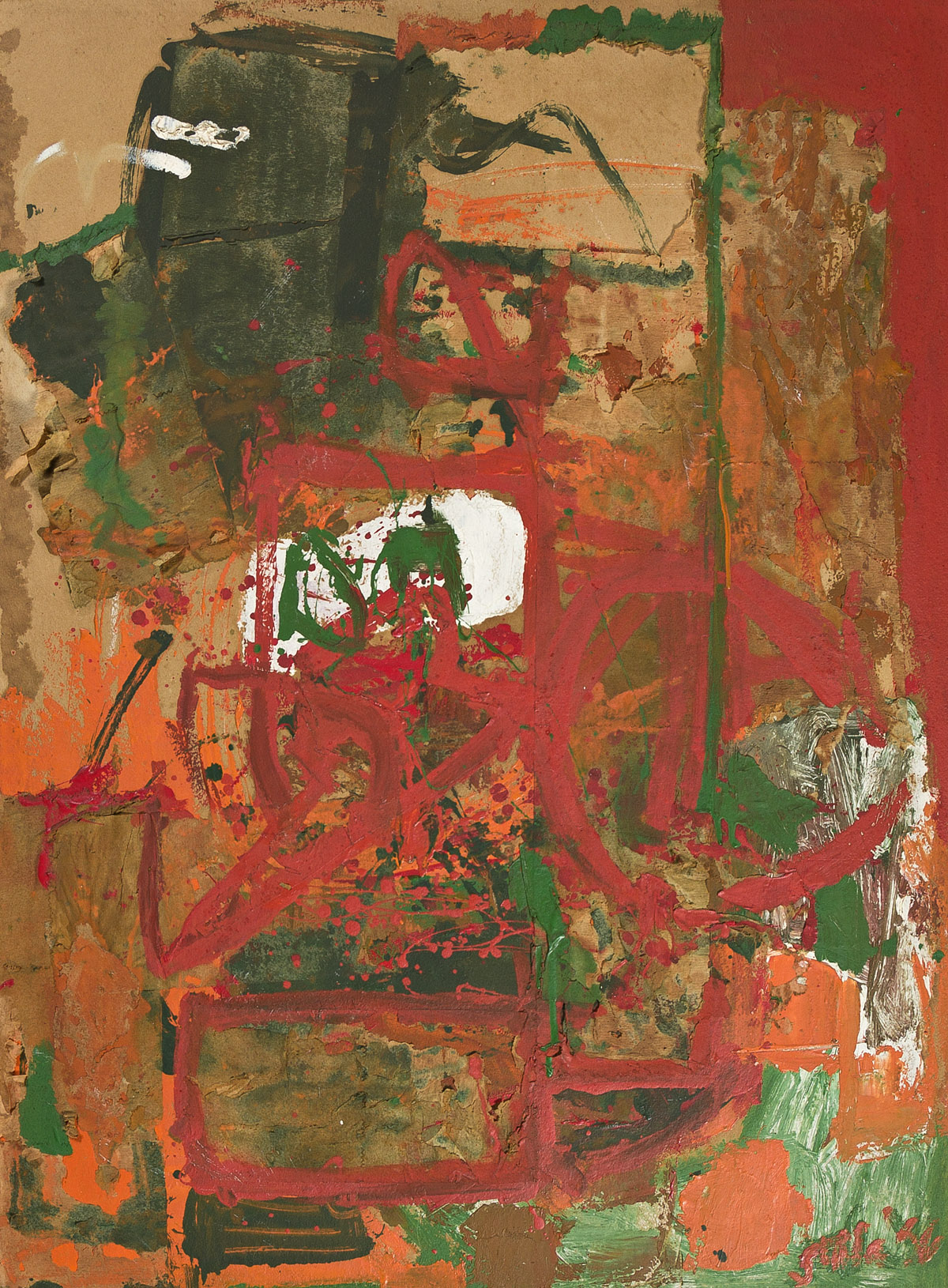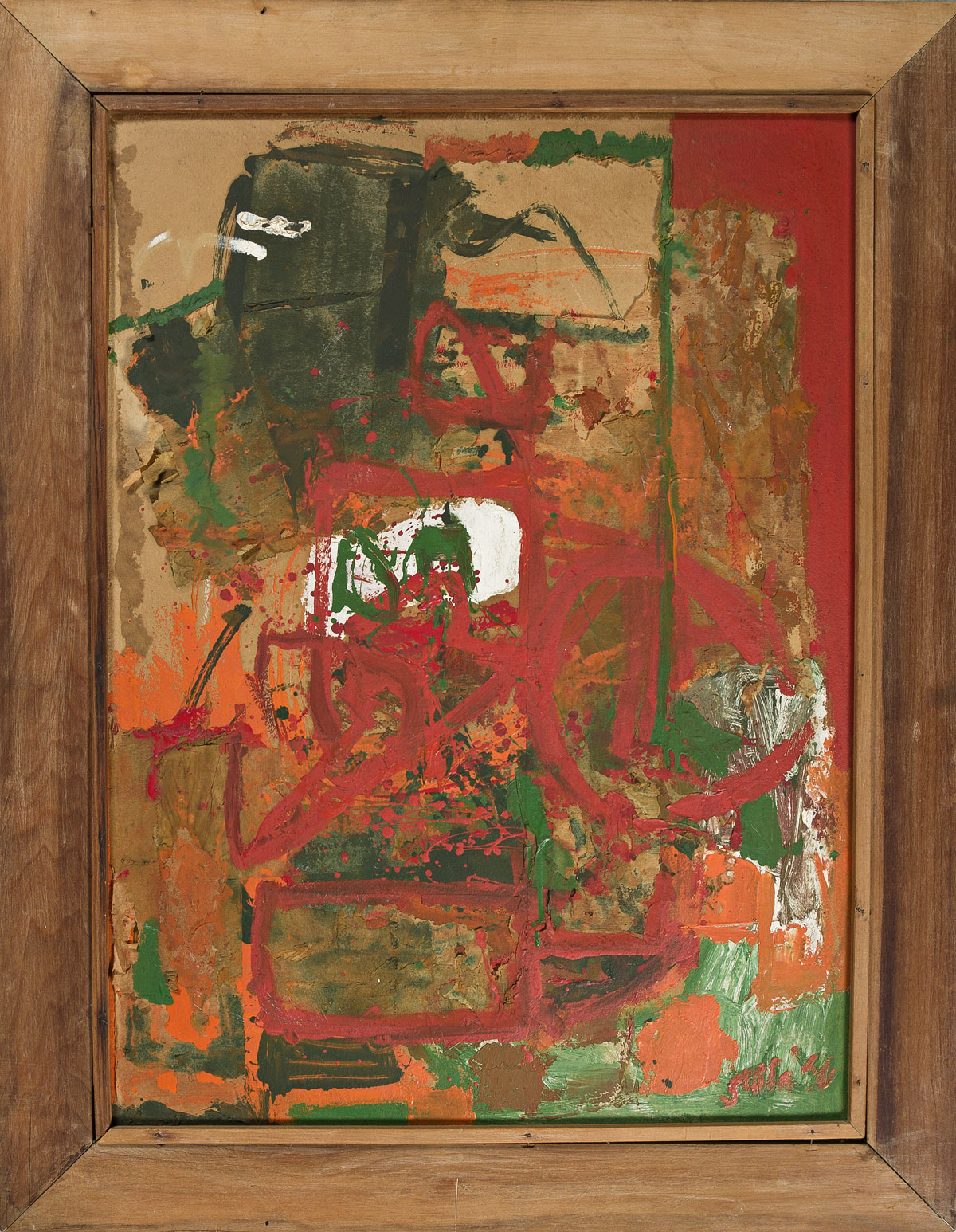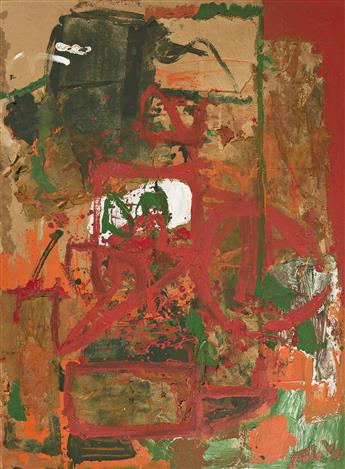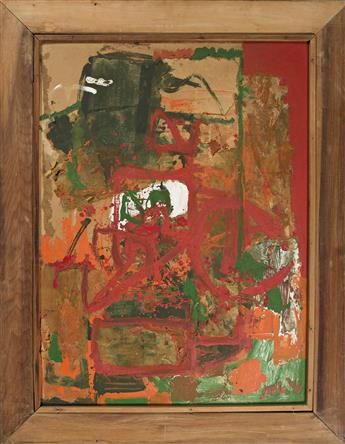Sale 2622 - Lot 6
Price Realized: $ 30,000
Price Realized: $ 37,500
?Final Price Realized includes Buyer’s Premium added to Hammer Price
Estimate: $ 30,000 - $ 50,000
FRANK STELLA
Untitled.
Oil with paper collage on found board, with vintage reproduction print verso, 1956. 862x635 mm; 34x25 1/4 inches. Signed and dated in oil, lower right recto.
The current early work, was made by Stella (born 1936) while a student at Princeton University. Stella had become acquainted with abstract art, and the work of Hans Hofmann and Josef Albers in particular, while attending high school at Phillips Academy in Andover, Massachusetts. Later on, while at Princeton University and through frequent trips to New York during the mid-1950s, he became influenced by the abstract expressionism of Jackson Pollock and Franz Kline.
According to a review in the Princeton Alumni Weekly, regarding an exhibition of Stella's early work ("1958": February 4, 2006-May 7, 2006, Arthur M. Sackler Museum, Harvard University Art Museums;May 26, 2006-August 20, 2006, The Menil Collection, Houston;September 16, 2006-December 31, 2006, Wexner Center for the Arts, Columbus) the author Mark F. Bernstein wrote, "Within 18 months of his graduation from Princeton, at a time in life when most of his classmates were sitting dully in law school classes or fumbling through their first jobs, Frank Stella [Princeton class of] '58 was one of the most important artists in the world, a comet who exploded Abstract Expressionism in a series of black, almost brutally minimalist paintings that seemed, in the words of art historian Robert Rosenblum, to 'close the door on what art could do.
When Stella first arrived in Princeton in 1954, the University's art department did not offer any drawing classes, which Stella--who majored in history--says suited him fine, as he had little interest in taking them. The following year, William C. Seitz, later a curator at the Museum of Modern Art, began to offer a noncredit, free-form drawing course that met, for lack of any other space, in the architects' work area at McCormick Hall. According to Darby Bannard [Princeton class of] '56, a close friend of Stella's and a noted abstract artist, the architecture students resented having to share their space with painters and would sometimes deface their work, leave wet paint on work stools, or scrawl signs asking, 'Is this art?'
A year later, Stephen Greene was hired to teach Princeton's first studio art class. Greene, Stella recalls, 'Taught in the traditional method. You brought in a model, you draw the model, and after you do it for a while you can paint. But I was kind of an annoying student. I didn't want to paint from the model. I just wanted to make paintings. So after a while [Greene] gave up and said, You're incorrigible. Just go ahead and make the paintings and forget about an art class.'
Traditional, representational art bored Stella. 'I just thought I was too far behind' what was going on in modern art to waste time sketching, he says. [Willem] de Kooning and [Franz] Kline had been fighting Picasso for years to take older painting styles, such as Cubism, to a new level in which painting was entirely nonrepresentational and non-objective,' Stella says. 'All of the painting that had developed from 1945 to 1950 had been a tremendous struggle to get through that and [the abstract expressionists] had come out on the other side. I wanted to start on the other side. I didn't want to have to fight a battle already won or lost.'"
Provenance: Gift from the artist to Sigurd G. Waaben, Princeton, a friend of the artist, as a wedding present, Waaben was a student at The Institute for Advanced Study, Princeton, at the time, and a hobbyist artist; thence by descent to current owner, private collection, New Jersey.
Untitled.
Oil with paper collage on found board, with vintage reproduction print verso, 1956. 862x635 mm; 34x25 1/4 inches. Signed and dated in oil, lower right recto.
The current early work, was made by Stella (born 1936) while a student at Princeton University. Stella had become acquainted with abstract art, and the work of Hans Hofmann and Josef Albers in particular, while attending high school at Phillips Academy in Andover, Massachusetts. Later on, while at Princeton University and through frequent trips to New York during the mid-1950s, he became influenced by the abstract expressionism of Jackson Pollock and Franz Kline.
According to a review in the Princeton Alumni Weekly, regarding an exhibition of Stella's early work ("1958": February 4, 2006-May 7, 2006, Arthur M. Sackler Museum, Harvard University Art Museums;May 26, 2006-August 20, 2006, The Menil Collection, Houston;September 16, 2006-December 31, 2006, Wexner Center for the Arts, Columbus) the author Mark F. Bernstein wrote, "Within 18 months of his graduation from Princeton, at a time in life when most of his classmates were sitting dully in law school classes or fumbling through their first jobs, Frank Stella [Princeton class of] '58 was one of the most important artists in the world, a comet who exploded Abstract Expressionism in a series of black, almost brutally minimalist paintings that seemed, in the words of art historian Robert Rosenblum, to 'close the door on what art could do.
When Stella first arrived in Princeton in 1954, the University's art department did not offer any drawing classes, which Stella--who majored in history--says suited him fine, as he had little interest in taking them. The following year, William C. Seitz, later a curator at the Museum of Modern Art, began to offer a noncredit, free-form drawing course that met, for lack of any other space, in the architects' work area at McCormick Hall. According to Darby Bannard [Princeton class of] '56, a close friend of Stella's and a noted abstract artist, the architecture students resented having to share their space with painters and would sometimes deface their work, leave wet paint on work stools, or scrawl signs asking, 'Is this art?'
A year later, Stephen Greene was hired to teach Princeton's first studio art class. Greene, Stella recalls, 'Taught in the traditional method. You brought in a model, you draw the model, and after you do it for a while you can paint. But I was kind of an annoying student. I didn't want to paint from the model. I just wanted to make paintings. So after a while [Greene] gave up and said, You're incorrigible. Just go ahead and make the paintings and forget about an art class.'
Traditional, representational art bored Stella. 'I just thought I was too far behind' what was going on in modern art to waste time sketching, he says. [Willem] de Kooning and [Franz] Kline had been fighting Picasso for years to take older painting styles, such as Cubism, to a new level in which painting was entirely nonrepresentational and non-objective,' Stella says. 'All of the painting that had developed from 1945 to 1950 had been a tremendous struggle to get through that and [the abstract expressionists] had come out on the other side. I wanted to start on the other side. I didn't want to have to fight a battle already won or lost.'"
Provenance: Gift from the artist to Sigurd G. Waaben, Princeton, a friend of the artist, as a wedding present, Waaben was a student at The Institute for Advanced Study, Princeton, at the time, and a hobbyist artist; thence by descent to current owner, private collection, New Jersey.
Exhibition Hours
Exhibition Hours
Aliquam vulputate ornare congue. Vestibulum maximus, libero in placerat faucibus, risus nisl molestie massa, ut maximus metus lectus vel lorem.






